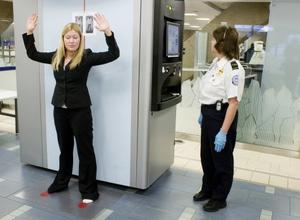EU supports full-body scanners, but says common standards for privacy, health are needed
An EC report says that full-body scanning at airports makes a contribution to security, but that a common framework must be developed across the European Union to protect citizens’ fundamental rights and health

Full body scanners in operation // Source: wordpress.com
The European Commission on Tuesday issued a report stating that full body scanners are a reliable screening method at airports. The EC says, though, that a common framework must be developed across the European Union to protect citizens’ fundamental rights and health.
“In order to end the current fragmented situation wherein Member States and airports decide ad-hoc if and how to deploy Security Scanners at airports, the use of Security Scanners must be based on common standards, requesting basic detection performance, and imposing safeguards to comply with European fundamental rights and health provisions,” the 19-page report (.pdf) submitted to the European Parliament and the Council argued.
Matthew Harwood writes that the rush to deploy to full body scanners occurred after the botched Christmas day attack when 23-year-old Nigerian Umar Farouk Abdulmutallab tried to detonate hidden explosives onboard a flight from Amsterdam to Detroit. Unlike metal detectors, proponents of full body scanners say the technology can detect both metallic and nonmetallic threats, such as the powdered explosives carried by Abdulmutallab.
The United States has been the most aggressive in deploying the scanners that can detect threats underneath a passenger’s clothing during at an airport security checkpoint. The United States is set to deploy 950 full body screeners by the end of 2011, and about 1,800 by the end of 2014, according to DHS.
Some E.U. countries are following the U.S. example. Airports in Finland, France, Italy, The Netherlands, and the United Kingdom have also deployed the machines in trial runs.
Critics of full body scanners argue the technology amounts to a virtual strip search, offends human dignity and religious prohibitions, and poses health risks.
The EC report, however, says the privacy and health concerns posed by full body scanners can be sufficiently addressed, especially as the underlying technologies evolve. The only technology the report determined could not be deployed for general aviation security was X-ray transmission imaging — which allows a screener to look inside human cavities — because of the radiation dose and the availability of effective alternatives, such as active millimeter wave, passive millimeter wave, and backscatter technologies, which use non- or low ionizing radiation (but see “RadPRO SecurPASS from Virtual Imaging,” 16 June 2010 HSNW, for low-dosage X-ray transmission imaging option).
The report says that while critics allege full body scanners would not have detected the powdered explosives Abdulmutallab stashed in his underwear, “the Security Scanners would have maximized the probability to detect the threats and will provide us with a considerably enhanced prevention
capability.”
Harwood writes that the report also notes that screening throughput times are acceptable and that some passengers prefer the full body scan to pat downs from security officers, finding the latter more intrusive.
Cost is another concern. Recent procurements of various full body scanners show the machines can run from approximately $125,000 to $300,000, which does not take into account deploying the machines, training screeners to use them, and purchasing software updates. Yet those costs must be weighed against increased efficiencies, like automatic threat recognition, and other considerations.
“The deployment of Security Scanners could in particular allow large airport[s] to get greater flexibility and potential to further strengthen aviation security as these airports could benefit from economies of scale and smoother deploy Security Scanners in their existing infrastructure,” the report states.
In the end, the European Commission is confident that full body scanners can be safely deployed within member states’ airports after legislation irons out the details. “A common level of protection for European citizens in this respect could be ensured by a way of technical standards and operational conditions that would have to be laid down in EU legislation,” the report concludes. “Only a EU approach would legally guarantee uniform application of security rules and standards throughout all EU airports.”
